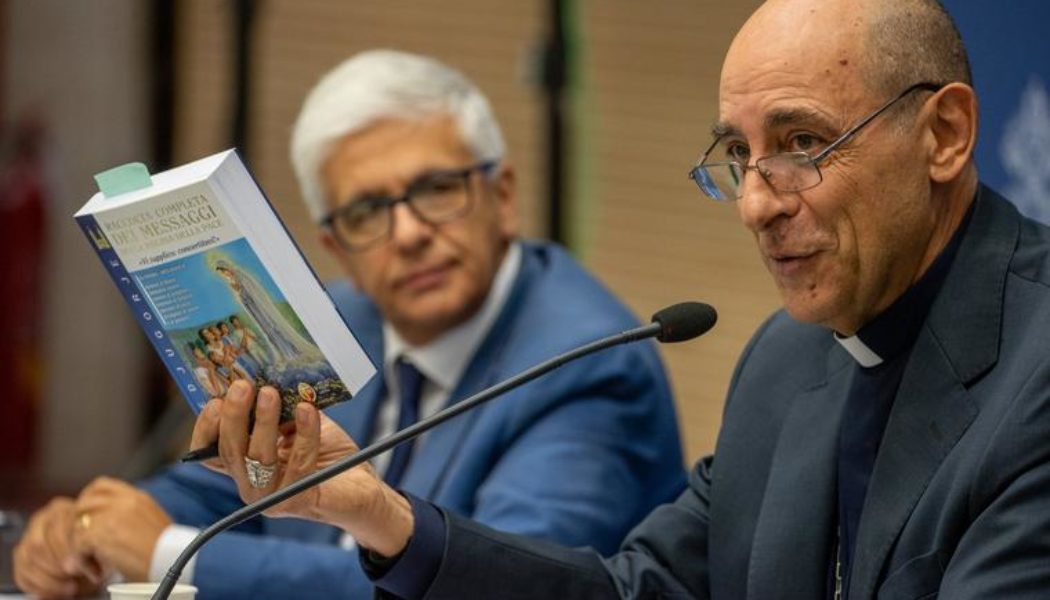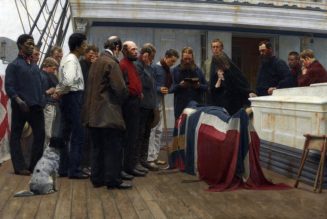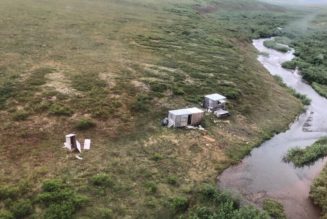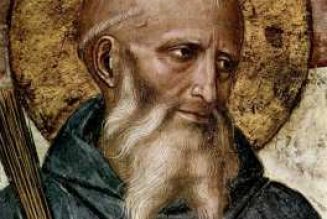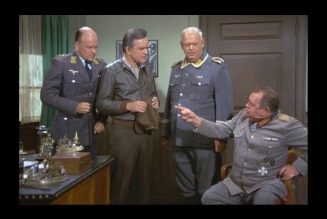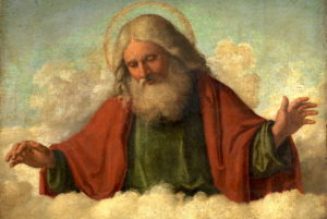
The Vatican has issued a cautious ruling allowing the faithful to benefit from the spiritual phenomena reported at Medjugorje, Bosnia and Herzegovina.
Cardinal Víctor Fernández, prefect of the Dicastery for the Doctrine of the Faith (DDF), announced the finding at a press conference accompanying the release of a document titled “‘The Queen of Peace’: Note About the Spiritual Experience Connected with Medjugorje.”
This document authorized the granting of a nihil obstat (Latin, “nothing obstructs”) for the phenomena, provided certain clarifications are understood.
The nihil obstat is one of the new categories introduced in May 2024, when the DDF issued its new “Norms for Proceeding in the Discernment of Alleged Supernatural Phenomena.” It does not imply the origin of an event to be supernatural but it is the most positive finding that can be obtained without the intervention of the pope. The norms define it this way:
“Nihil obstat — Without expressing any certainty about the supernatural authenticity of the phenomenon itself, many signs of the action of the Holy Spirit are acknowledged ‘in the midst’ of a given spiritual experience, and no aspects that are particularly critical or risky have been detected, at least so far. For this reason, the Diocesan Bishop is encouraged to appreciate the pastoral value of this spiritual proposal, and even to promote its spread, including possibly through pilgrimages to a sacred site.”
History of the Apparitions
The new ruling provides the dicastery’s answer to a long-standing and controversial question about the phenomena at Medjugorje.
In 1981, six young people began reporting apparitions of the Virgin Mary in Medjugorje, which was then part of Yugoslavia. These apparitions included many messages, which were reported on a daily basis. Three of the individuals still report receiving messages from Mary daily, while the other three only report them on special occasions.
The alleged messages also contained 10 secrets about future events that have not been publicly disclosed. One concerns a permanent sign that will appear on the hill where the apparitions first occurred.
After the apparitions began to be reported, the local bishop at the time, Bishop Pavao Zanic of Mostar-Duvno, appointed two commissions to study them. However, the site’s popularity grew to the point that the Yugoslavian bishops’ conference established a third commission.
At the time, bishops were seeking to issue one of three rulings concerning apparitions: constat de supernaturalitate (“established as supernatural”), non constat de supernaturalitate (“not established as supernatural”) or constat de non supernaturalitate (“established as not supernatural”).
In 1991, the Yugoslavian bishops issued a finding of “not established as supernatural,” but this did not end the matter, and worldwide interest in Medjugorje led the Vatican to have greater involvement.
In 2010, Benedict XVI instituted a new commission under the auspices of the then-Congregation for the Doctrine of the Faith, and it privately delivered its report to the congregation in 2014.
The commission reportedly found the earliest Medjugorje apparitions worthy of further investigation, but it doubted the later ones. Commenting on the report in 2017, Pope Francis stated:
“As far as the presumed present apparitions go, the report has its doubts. I personally am harsher. I prefer the Madonna as mother, our mother, not the Madonna of the post office, who delivers a message every day at a set hour. … This is not Jesus’s mother. These presumed apparitions are not worth much. That’s my personal opinion.”
At this point, the Holy See had a dilemma. On the one hand, there were significant doubts about the supernaturality of much of the Medjugorje phenomena. On the other hand, if they gave a ruling of non-supernaturality, it would be a crushing blow to the alleged apparitions’ many worldwide followers.
Seven Categories for Discernment
A seismic shift occurred in May, when the new norms for discerning supernatural phenomena were announced. No longer would the three traditional rulings be used. Instead, seven categories were introduced, and while constat de supernaturalite still existed, it could be pursued only at the direction of the pope, and so the focus of the investigation would not be primarily on whether the phenomena in an apparition were of supernatural origin.
Cardinal Fernández stated that, by shifting the emphasis, it would allow bishops to more quickly arrive at rulings that otherwise took far too long — including for problematic apparitions that gained large followings due to the delay.
At the time, some — including me — proposed that a ruling on Medjugorje might be made soon, as the new categories gave more options for how to handle it. Further, one of the new categories seemed tailor-made for Medjugorje:
“Curatur — While various or significant critical elements are noted, at the same time, the phenomenon has already spread widely, and there are verifiable spiritual fruits connected to it. In this situation, a ban that could upset the People of God is not recommended. Nevertheless, the Diocesan Bishop is asked not to encourage this phenomenon but to seek out alternative expressions of devotion and possibly reorient its spiritual and pastoral aspects.”
However, I noted that when Cardinal Fernández was asked about Medjugorje, he said that he had not reviewed the commission findings on it yet, and he envisioned another option: giving it a nihil obstat with a clarification. He said:
“Keep in mind that a phenomenon can be considered good, not dangerous at the origin, but it may have some issues in its later development. Therefore, sometimes a declaration needs to clarify these different stages: That’s a distinction we need to consider. And then, suppose there was a green light, a Nihil Obstat, we might also need to clarify that some details should not be taken seriously. If I remember correctly, the Madonna there was giving orders, setting the schedule, the place, what the bishop should do, etc. That needs to be clarified.”
This ended up being the path that was pursued in the new “Queen of Peace” document.
The New Document
The 10,000-word document contains three primary sections. The first is a discussion of the spiritual fruits connected with Medjugorje, which it acknowledges are real, and it cites “abundant conversions, a frequent return to the sacraments (particularly, the Eucharist and reconciliation), many vocations to priestly, religious and married life, a deepening of the life of faith, a more intense practice of prayer, many reconciliations between spouses, and the renewal of marriage and family life” (3).
The second section is an analysis of the central aspects of the messages. It focuses on Mary as Queen of Peace, the peace that flows through love, Jesus as the King of Peace, a focus on the centrality of God and of Christ, the action of the Holy Spirit, the call to conversion, the heavy burden of evil and sin in the world, prayer, the centrality of the Mass, fraternal communion, joy and gratitude, the witness of the faithful, and eternal life.
The third section provides clarifications that the DDF deems necessary. These include reprimands and threats made in the messages, messages directed at the parish in Medjugorje, a relentless insistence on listening to the messages, the need to focus on the word of God, the “self-exaltation” of Mary in them, and the need to focus on God and Christ.
The DDF stresses that reported messages are not to be taken as perfectly reflecting the will of heaven.
“When one recognizes an action of the Holy Spirit in the midst of a spiritual experience, it does not mean that everything belonging to that experience is thereby free from all imprecisions, imperfections, and areas of possible confusion. Once again, one should remember that these phenomena may ‘at times appear connected to confused human experiences, theologically inaccurate expressions, or interests that are not entirely legitimate’ (‘Norms,’ par. 14). This does not exclude the possibility of ‘some error of a natural order, not due to bad intentions, but to the subjective perception of the phenomenon’ (ibid., art. 15, 2°)”.
The DDF identifies some messages as “misleading” and notes that they are particularly problematic when messages “refer to requests that are unlikely to be of supernatural origin, such as when Our Lady gives orders about specific dates, places, and practicalities and when she makes decisions about ordinary matters” (30). It concludes:
“It is reasonable for the faithful, using prudence and common sense, not to take these details seriously nor heed them. One must always recall that in this spiritual experience (as in other spiritual experiences and alleged supernatural phenomena), positive and edifying elements are mixed with other elements that are to be ignored. But this fact should not lead one to spurn the richness and the good of the Medjugorje proposal as a whole.”
The document’s conclusion stresses three times that it is not ruling on whether the Medjugorje apparitions are of supernatural origin. Instead, it says that “the Nihil obstat indicates that the faithful can receive a positive encouragement for their Christian life through this spiritual proposal” (38).
In 2018, Pope Francis appointed an apostolic visitor (currently Archbishop Aldo Cavalli) to oversee the pastoral needs of pilgrims to the site, and the new document confirms his ongoing role. In particular, it notes that the apostolic visitor is to ensure that the “Queen of Peace” document is included as an introduction to all collections of alleged messages from Medjugorje to help the faithful in discerning them. The apostolic visitor is also to discern any further messages, including existing ones that are not yet public, and his approval is required before they are published.
The document also ensures the right of local bishops worldwide to monitor how those in their dioceses are presenting the Medjugorje phenomena and take corrective action if needed.
Where Are We Now?
The new document attempts to pull off the delicate balancing act of integrating the positive elements of Medjugorje into the life of the Church while at the same time neutralizing its negative aspects. How well it will work in practice remains to be seen.
At the same time, it — by design — leaves unanswered the question of whether Medjugorje is of supernatural origin, and it notes that “there may be different opinions about the authenticity of some facts or certain aspects of this spiritual experience” (40).
It is unlikely that a ruling on supernaturality will be undertaken in the near future. Catholic Review reports:
“While it is possible that a Pope could go further and make a declaration about whether the alleged apparitions and messages have a supernatural origin, Cardinal Fernández said he asked Pope Francis if he wanted to move in that direction and the Pope said, ‘Not at all.’”
This is not unexpected considering the Pope’s previously expressed skepticism concerning the apparitions, and it leaves us essentially in the same place as we were before.
Those who favor the supernatural origin of the apparitions may continue to do so, though the DDF has now warned them against placing too much credence in all of the messages, saying that some are “misleading” and that “positive and edifying elements are mixed with other elements that are to be ignored” (30).
On the other hand, those who oppose the supernatural origin of the apparitions may also continue to do so, though the DDF has acknowledged that — even if the apparitions are not supernatural — “in the midst of this phenomenon, the Holy Spirit is carrying out many beautiful and positive things” (5).
